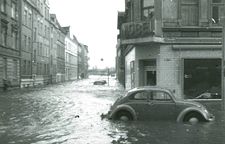Flood of 1962

Flooded streets in Hamburg-Wilhelmsburg
|
|
| Date | 16–17 February 1962 |
|---|---|
| Location | North Sea coast of Germany and the Netherlands |
| Deaths | 347 |
| Property damage | DM 3 billion (Hamburg only) |
The North Sea flood of 1962 was a natural disaster affecting mainly the coastal regions of Germany and in particular the city of Hamburg in the night from 16 February to 17 February 1962. In total, the homes of about 60,000 people were destroyed, and the death toll amounted to 315 in Hamburg. In addition, three people were killed in the United Kingdom by high winds, which damaged around 175,000 houses in the worst affected city, Sheffield.
The flood was caused by the Vincinette low-pressure system, approaching the German Bight from the southern Polar Sea. A European windstorm with peak wind speeds of 200 km/h pushed water into the German Bight, leading to a water surge the dykes could not withstand. Breaches along the coast and the rivers Elbe and Weser led to widespread flooding of huge areas. In Hamburg, on the river Elbe, but a full 100 km away from the coast, the residential areas of Wilhelmsburg was most affected.
On Thursday 15 February, German authorities published the first storm warning for the North Sea with wind speeds up to 9 Beaufort. A severe storm warning followed the next day, with a predicted gauge of 3 Metres above normal, which was a level the dykes could withstand.
The severe storm and the flood it caused in the last hours of 16 February affected the dykes more than predicted and led to some 50 breaches before officials raised alarm for Hamburg. At this time of the day, most city offices were closed, which retarded the notification of the population. Civil protection plans were not implemented yet.
Due to telephone landline breakups, warnings could not be forwarded from coastal to hinterland emergency offices. Breakups at alarm siren lines and electricity lines affected the warning system severely. Radio amateurs had to establish emergency operations to support emergency services in means of communication.
Around midnight, the peaks were too high for some dykes to withstand. The back of the dykes was not yet fortified, so the first waters destroyed the dykes from behind and cleared the way for the flood.
...
Wikipedia
